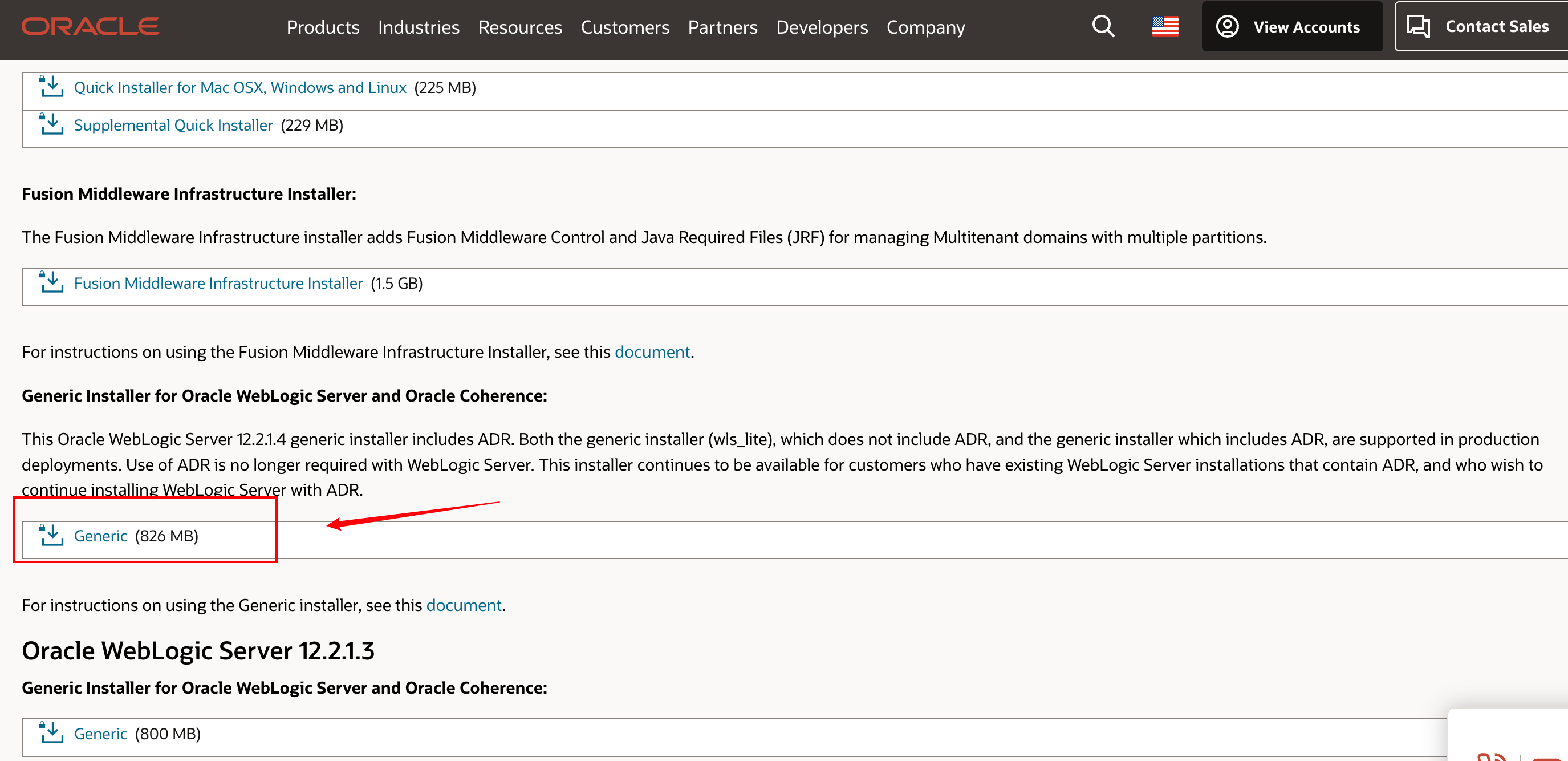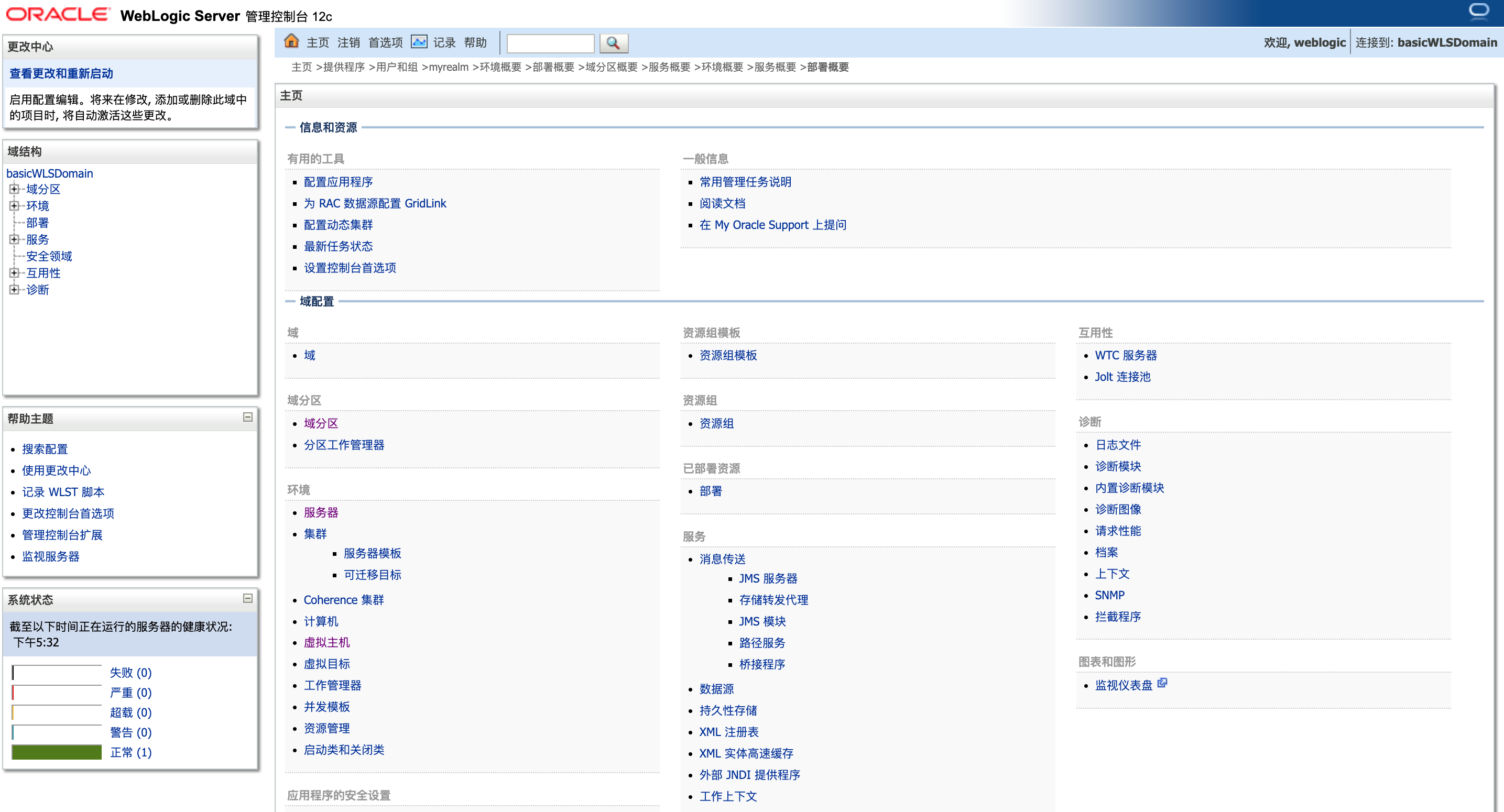WebLogic 安装部署
最近在跟客户搞持续部署,客户这边很多 Java 项目使用的应用服务器都是 WebLogic,因此为了更加方便自己调试一些命令,减少对测试环境甚至生产环境的侵害,我打算自己搭建一套本地 WebLogic 环境来验证一下操作,本篇记录一下环境部署。
1. 安装 JDK 环境
安装 JDK 环境的步骤这里不做说明,我博客有相关操作文档。
使用 java -version 来验证:
root@weblogic:~# java -version
java version "1.8.0_411"
Java(TM) SE Runtime Environment (build 1.8.0_411-b09)
Java HotSpot(TM) 64-Bit Server VM (build 25.411-b09, mixed mode)2. 创建用户和组
WebLogic 一般使用 weblogic 用户来启动,因此一般创建一个 weblogic 和同名的用户组:
sudo groupadd weblogic
sudo useradd -g weblogic -s /bin/bash -m weblogic
sudo passwd weblogic3. 安装 WebLogic
3.1 下载 WebLogic 安装包
从 Oracle 官网 下载安装包,跟下载 JDK 包一样,需要注册和登录 Oracel 账号才可以下载.
下载的时候选择 Generic 的:

下载后可以得到一个类似这种的压缩包:fmw_12.2.1.4.0_wls_lite_Disk1_1of1.zip
3.2 上传并解压安装包
将下载的安装包压缩文件上传到服务器上面任意位置,并解压文件,此时可以得到一个 jar 包,如 fmw_12.2.1.4.0_wls_lite_generic.jar
unzip fmw_12.2.1.4.0_wls_lite_Disk1_1of1.zip3.3 使用配置文件静默安装
首先,切换到 weblogic 用户:
su weblogic然后创建一个目录用来放置响应文件(静默安装的配置文件):
mkdir -p /home/weblogic/response_files在该目录下创建一个响应文件(比如wls_silent_install.rsp),内容如下:
[ENGINE]
#DO NOT CHANGE THIS.
Response File Version=1.0.0.0.0
[GENERIC]
# The oracle home location. This can be an existing Oracle Home or a new Oracle Home
ORACLE_HOME=/home/weblogic/Oracle/Middleware
# Set this variable value to the Installation Type selected. e.g. Fusion Middleware Infrastructure, Fusion Middleware Infrastructure With Examples.
INSTALL_TYPE=WebLogic Server
# Provide the My Oracle Support Username. If you wish to ignore Oracle Configuration Manager configuration provide empty string for user.
MYORACLESUPPORT_USERNAME=
# Provide the My Oracle Support Password
MYORACLESUPPORT_PASSWORD=<YOUR_PASSWORD_HERE>
# Set this to true if you wish to decline the security updates.
DECLINE_SECURITY_UPDATES=true
# Set this to true if My Oracle Support Password is specified.
SECURITY_UPDATES_VIA_MYORACLESUPPORT=false
# Provide the Proxy Host
PROXY_HOST=
# Provide the Proxy Port
PROXY_PORT=
# Provide the Proxy Username
PROXY_USER=
# Provide the Proxy Password
PROXY_PWD=
# Type String (URL format) Indicates the OCM Repeater URL to be used to upload the RDA results.
COLLECTOR_SUPPORTHUB_URL=
# The directory where the latest support library patches are stored. This directory will be searched for the patches needed for the installation.
SUPPORT_LIBRARIES_PATH=备注:这里只需要关注一个配置项 ORACLE_HOME 就行,这个配置的注释也说明了作用,并且特意说了需要给予目录足够的权限。
再创建一个 oraInst.loc 配置文件,内容如下:
inventory_loc=/home/weblogic/oraInventory
inst_group=weblogic备注:
- inventory_loc: 表示产品清单目录
- inst_group: 表示 weblogic 用户所在的组名
最后加载环境变量配置文件,并执行安装命令(注意三个文件的路径根据实际填写):
source /etc/profile
java -jar /opt/software/fmw_12.2.1.4.0_wls_lite_generic.jar -silent -responseFile /home/weblogic/response_files/wls_silent_install.rsp -invPtrLoc /home/weblogic/response_files/oraInst.loc看到类似如下输出就是安装成功:
...
Validations are enabled for this session.
Verifying data
Copying Files
Percent Complete : 10
Percent Complete : 20
Percent Complete : 30
Percent Complete : 40
Percent Complete : 50
Percent Complete : 60
Percent Complete : 70
Percent Complete : 80
Percent Complete : 90
Percent Complete : 100
The installation of Oracle Fusion Middleware 12c WebLogic Server and Coherence 12.2.1.4.0 completed successfully.
Logs successfully copied to /home/weblogic/oraInventory/logs.4. 创建域
首先,创建域配置响应文件,这里可以直接复制 Weblogic 自带的模板,复制命令如下:
cp /home/weblogic/Oracle/Middleware/wlserver/common/templates/scripts/wlst/basicWLSDomain.py /home/weblogic/response_files/create_domain.py然后修改一下配置中的参数即可:
#=======================================================================================
# This is an example of a simple WLST offline configuration script. The script creates
# a simple WebLogic domain using the Basic WebLogic Server Domain template. The script
# demonstrates how to open a domain template, create and edit configuration objects,
# and write the domain configuration information to the specified directory.
#
# This sample uses the demo Derby Server that is installed with your product.
# Before starting the Administration Server, you should start the demo Derby server
# by issuing one of the following commands:
#
# Windows: WL_HOME\common\derby\bin\startNetworkServer.cmd
# UNIX: WL_HOME/common/derby/bin/startNetworkServer.sh
#
# (WL_HOME refers to the top-level installation directory for WebLogic Server.)
#
# The sample consists of a single server, representing a typical development environment.
# This type of configuration is not recommended for production environments.
#
# Please note that some of the values used in this script are subject to change based on
# your WebLogic installation and the template you are using.
#
# Usage:
# java weblogic.WLST <WLST_script>
#
# Where:
# <WLST_script> specifies the full path to the WLST script.
#=======================================================================================
#=======================================================================================
# Open a domain template.
#=======================================================================================
readTemplate("/home/weblogic/Oracle/Middleware/wlserver/common/templates/wls/wls.jar")
#=======================================================================================
# Configure the Administration Server and SSL port.
#
# To enable access by both local and remote processes, you should not set the
# listen address for the server instance (that is, it should be left blank or not set).
# In this case, the server instance will determine the address of the machine and
# listen on it.
#=======================================================================================
cd('Servers/AdminServer')
set('ListenAddress','')
set('ListenPort', 7001)
create('AdminServer','SSL')
cd('SSL/AdminServer')
set('Enabled', 'True')
set('ListenPort', 7002)
#=======================================================================================
# Define the user password for weblogic.
#=======================================================================================
cd('/')
cd('Security/base_domain/User/weblogic')
cmo.setPassword('weblogic123')
# Please set password here before using this script, e.g. cmo.setPassword('value')
#=======================================================================================
# Create a JMS Server.
#=======================================================================================
cd('/')
create('myJMSServer', 'JMSServer')
#=======================================================================================
# Create a JMS System resource.
#=======================================================================================
cd('/')
create('myJmsSystemResource', 'JMSSystemResource')
cd('JMSSystemResource/myJmsSystemResource/JmsResource/NO_NAME_0')
#=======================================================================================
# Create a JMS Queue and its subdeployment.
#=======================================================================================
myq=create('myQueue','Queue')
myq.setJNDIName('jms/myqueue')
myq.setSubDeploymentName('myQueueSubDeployment')
cd('/')
cd('JMSSystemResource/myJmsSystemResource')
create('myQueueSubDeployment', 'SubDeployment')
#=======================================================================================
# Create and configure a JDBC Data Source, and sets the JDBC user.
#=======================================================================================
cd('/')
create('myDataSource', 'JDBCSystemResource')
cd('JDBCSystemResource/myDataSource/JdbcResource/myDataSource')
create('myJdbcDriverParams','JDBCDriverParams')
cd('JDBCDriverParams/NO_NAME_0')
set('DriverName','org.apache.derby.jdbc.ClientDriver')
set('URL','jdbc:derby://localhost:1527/db;create=true')
set('PasswordEncrypted', 'PBPUBLIC')
set('UseXADataSourceInterface', 'false')
create('myProps','Properties')
cd('Properties/NO_NAME_0')
create('user', 'Property')
cd('Property/user')
cmo.setValue('PBPUBLIC')
cd('/JDBCSystemResource/myDataSource/JdbcResource/myDataSource')
create('myJdbcDataSourceParams','JDBCDataSourceParams')
cd('JDBCDataSourceParams/NO_NAME_0')
set('JNDIName', java.lang.String("myDataSource_jndi"))
cd('/JDBCSystemResource/myDataSource/JdbcResource/myDataSource')
create('myJdbcConnectionPoolParams','JDBCConnectionPoolParams')
cd('JDBCConnectionPoolParams/NO_NAME_0')
set('TestTableName','SYSTABLES')
#=======================================================================================
# Target resources to the servers.
#=======================================================================================
cd('/')
assign('JMSServer', 'myJMSServer', 'Target', 'AdminServer')
assign('JMSSystemResource.SubDeployment', 'myJmsSystemResource.myQueueSubDeployment', 'Target', 'myJMSServer')
assign('JDBCSystemResource', 'myDataSource', 'Target', 'AdminServer')
#=======================================================================================
# Write the domain and close the domain template.
#=======================================================================================
setOption('OverwriteDomain', 'true')
writeDomain('/home/weblogic/Oracle/Middleware/wlserver/../user_projects/domains/basicWLSDomain')
closeTemplate()
#=======================================================================================
# Exit WLST.
#=======================================================================================
exit()可以按需修改的配置:
1、修改默认端口7001:
cd('Servers/AdminServer')
set('ListenAddress','')
set('ListenPort', 7001)2、设置 weblogic 控制台的登录密码:
cd('/')
cd('Security/base_domain/User/weblogic')
cmo.setPassword('weblogic123')配置修改完成后,加载一下 weblogic 的环境变量文件:
source /home/weblogic/Oracle/Middleware/wlserver/server/bin/setWLSEnv.sh然后执行创建命令:
/home/weblogic/Oracle/Middleware/wlserver/common/bin/wlst.sh /home/weblogic/response_files/create_domain.py正常的输出如下:
weblogic@weblogic:~$ /home/weblogic/Oracle/Middleware/wlserver/common/bin/wlst.sh /home/weblogic/response_files/create_domain.py
WARNING: This is a deprecated script. Please invoke the wlst.sh script under oracle_common/common/bin.
Initializing WebLogic Scripting Tool (WLST) ...
Welcome to WebLogic Server Administration Scripting Shell
Type help() for help on available commands
Exiting WebLogic Scripting Tool.5. 启动服务
进入启动脚本目录:
cd /home/weblogic/Oracle/Middleware/user_projects/domains/basicWLSDomain/bin启动服务:
sh startWebLogic.sh然后就可以访问控制台,输入地址:http://ip:7001/console 就可以登录。

验证没问题后,可以在后台启动服务:
nohup sh startWebLogic.sh &